This
exhibition marks the culmination of ‘Community in Clay’, my doctoral project
based on the 19th century Sunderland pottery collection at
Sunderland Museum & Winter Gardens (SMWG), and features work I have made
over the last three years, including a significant number of new pieces made in
the last few months. This post will focus on some of the main works, relating
them to my research and the historic pottery collection.
 |
| The Pottery Gallery at Sunderland Museum & Winter Gardens. My cabinet is next to the bust of Robert Burns. Photograph by Colin Davison, 2013. |
The
display is housed in the New Acquisitions cabinet in SMWG’s Pottery Gallery
which Shauna Gregg, Keeper of Fine and Decorative Art, kindly emptied for me
prior to my display. The cabinet comprises four shelves, with the newer work
displayed on the higher ones and earlier pieces lower down. This forms a
chronological ‘strata’ showing how my work has evolved over the course of the
research period.
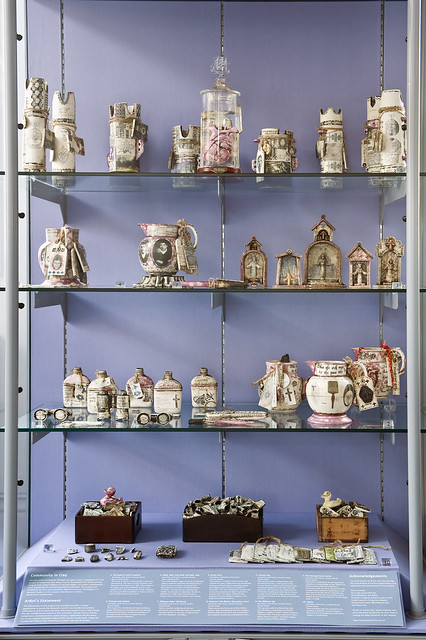 |
| A detail of the cabinet showing the four levels. Photograph by Colin Davison, 2013. |
The
centrepiece of the display, on the highest shelf, is ‘The Heart of Jack
Crawford’, a glass and porcelain re-imagining of what was referred to in 1887, by
the editor of the Monthly Chronicle of North Country Lore and Legend, quoting a
correspondent of the Sunderland Daily Post, as “a glass jar labelled as
containing the heart of the hero of Camperdown” which had been donated to the Borough
Museum of Sunderland (now SMWG) (Editor 1887). Sunderland-born Crawford
(1775-1831) is said to have risked his life nailing Admiral Duncan’s colours to
the mast, thereby helping to win the Battle of Camperdown (1797). Initially fêted nationally, Crawford later
descended into alcoholism and was one of the first people to succumb to cholera
in Sunderland in 1831. Reseacrh with the 19th century accessions
register at SMWG did indeed confirm that something described as “The Heart of
Jack Crawford” entered the collection in September 1882, although further
enquiry suggests that this item was not the genuine article and it appears to
have been deaccessioned sometime ago.
 |
| The Heart of Jack Crawford. Thanks to James Maskrey and Wearside Glass Sculptures for making the glass elements of this piece. Photograph by Christopher McHugh, 2013. |
This
work develops upon earlier items which were displayed in ‘The Heart of JackCrawford: A Shrine to Unsung Heroes’, my solo show in the Gallery of Wonder,
Great North Museum: Hancock in 2011. The heart is slipcast porcelain with a
clear glaze and pink lustre. The glass bottle was kindly made by James Maskrey
and the ship finial and wooden trophy stand were provided by Wearside Glass Sculptures, both based at the National Glass Centre, University of Sunderland. James’s
work often investigates historical events and he has recently made a series of
glass work relating to Scott’s Terra Nova expedition which has been acquired by
the Crafts Council. Referencing
the numerous heroic depictions of Jack Crawford on pots in the SMWG’s
collection, this piece attempts to create a slightly tongue-in-cheek dramatisation
of this urban myth, whilst also intending to stimulate a more serious consideration
of how contemporary acts of bravery are commemorated. It is hoped that this
celebration of this all but forgotten hero will have current resonance,
particularly at a time when many men and women from the North East are serving
their country in conflicts abroad.
‘The
Heart of Jack Crawford’ is flanked by a series of porcelain vessels which I
have made since returning from my three month placement (Jan-April 2013) at the
National Museum of Ethnology, Japan. Here, I carried out research on the George Brown Collection, an assemblage of over 3000 Oceanic objects collected by the
Barnard Castle-born Methodist missionary (1835-1917) during his time in the
South Pacific in the later part of the 19th century. These vessels
are inspired by a collection of decorated bamboo lime containers from the
Solomon Islands. In Melanesia, lime, derived from charred coral or shells, was
mixed with betel nut and chewed as a mild stimulant. Some of the vessels are hand-built
while others are slipcasts taken from a piece of bamboo sourced in Japan. Surface
decoration is provided through the use of wooden stamps based on the incised
decoration of the original containers. Taking photographs using the Instagram
application provided an immediate method to visually document my time in Japan
and some of this contemporary imagery has been used to create digital ceramic
decals which have been synthesised with the stamped elements. Brown accumulated
this collection during an age of exploration and colonisation and its strength
as an ethnographic record lies in the fact that much of it was collected before
widespread Western contact with the source communities. At this time,
Sunderland pottery was at its apogee; the city was a busy port and pots bearing
maritime imagery are common.
 |
| Some of the vessels in the George Brown Series. Photograph by Christopher McHugh, 2013. |
The
next layer features the ‘Crinson Jug’ and the ‘Milburn Jug’ which represent the
history of two venerable Sunderland pottery families. Two of the Crinson
brothers shown on the jug served at the Battle of the Somme as members of the
Durham Light Infantry, the ‘ancestors’ of Third Battalion, The Rifles (3Rifles).
In ‘conversation’ with these is ‘Rifleman Hiles’ IED Brush’, a recreation in
porcelain of the real tool used by Hiles to excavate ‘improvised explosive
devices’ on his 2011 tour in Afghanistan with 3 Rifles. The original item was
marked with a tally showing the number of devices successfully found and this
information has been printed onto a ceramic tag attached to the brush. A
Sunderland mug from 1842 in the DLI Museum commemorates the death of Thomas
Brown, a soldier in the Durham Light Infantry, and provides an interesting
precedent. Other examples of Sunderland pottery commemorating historical
military campaigns, including the Crimean War and the Battle of Trafalgar, can
be found in the Wartime cabinet, next to my display.
To
the right of the jugs is ‘Grow Jesus’, a work composed of five stoneware
shrines containing porcelain Jesus figurines of various sizes. Again, this is
an attempt to materialise an anecdote told by another member of 3 Rifles, where
he recounted how he had coped with boredom and stress in Afghanistan by
periodically soaking and reshrinking a water-expandable plastic Jesus toy sent
to him by a member of the British public. I recreated this process using a similar
item acquired online, taking plaster moulds at various stages of engorgement.
Porcelain casts were taken, thereby capturing the cyclical process of growth
and shrinkage in order to create a monument to this potentially ephemeral
narrative.
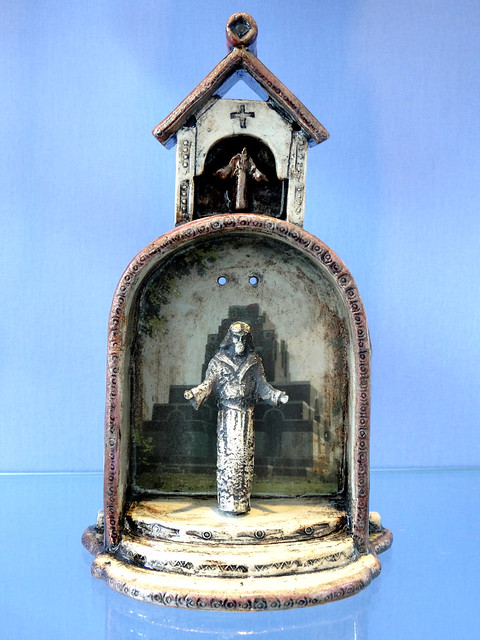 |
| One of the Grow Jesus shrines with the Thiepval Monument to the Missing of the Somme in the background. Photograph by Christopher McHugh, 2013. |
Further
3 Rifles-related pieces, collectively described as ‘Explorer’s Kit’, including
the porcelain jugs, flasks and binoculars previously exhibited as part of Kith and Kin: New Glass and Ceramics, are displayed below this level. A new jug
named after the motto of the battalion - “Swift and Bold” - brings together
printed images of the soldiers’ tattoos and lucky charms. During the heyday of
Sunderland pottery, local lads looking for employment and adventure, like Jack
Crawford, and later George Brown, went off to sea to explore the world. These
days, young people in a similar position might decide to join the armed forces.
Indeed, a significant proportion of recruits to 3 Rifles comes from the North
East, with others coming from former colonies like Fiji, one of the places
where George Brown was active as a missionary.
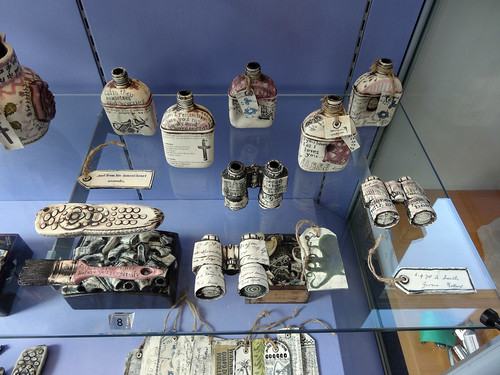 |
| Detail of Explorer's Kit. Photograph by Christopher McHugh, 2013. |
A reworking
of ‘Flotsam and Jetsam’, an ever-growing piece consisting of multiple cast
porcelain objects, forms the bottom layer. Rather than a glass shelf like the
others, this level is wrapped in the blue fabric case lining and these
fictitious archaeological ‘small finds’ gain further credence from this traditional
museum display format. Chronologically, this work is the earliest on display,
first shown as part of the group show, Unfinished Business at Wallington. The
boots, cast from moulds of Action Man boots, are inscribed with text, some of
which is based on poetry and prose written by members of the Foyle Street
Writers after a workshop in the Pottery Gallery. Alongside the many intact pots
in the Sunderland collection are some pot sherds excavated from the sites of
former Sunderland potteries. My ‘contemporary relics’ perhaps serve as a memento
mori, inviting us to ponder what material remnants will be left of our society
in the future. This time, the majority of the small elements are housed in
three old wooden boxes sourced from a Japanese flea market. These boxes,
brought back from a country which has recently suffered a combined natural and
man-made disaster, where people’s homes and memories have literally been washed
away, are intended to add an extra degree of poignancy to this iteration of
‘Flotsam and Jetsam’, and are an abridged form of a larger scale installation I
held while I was in Japan.
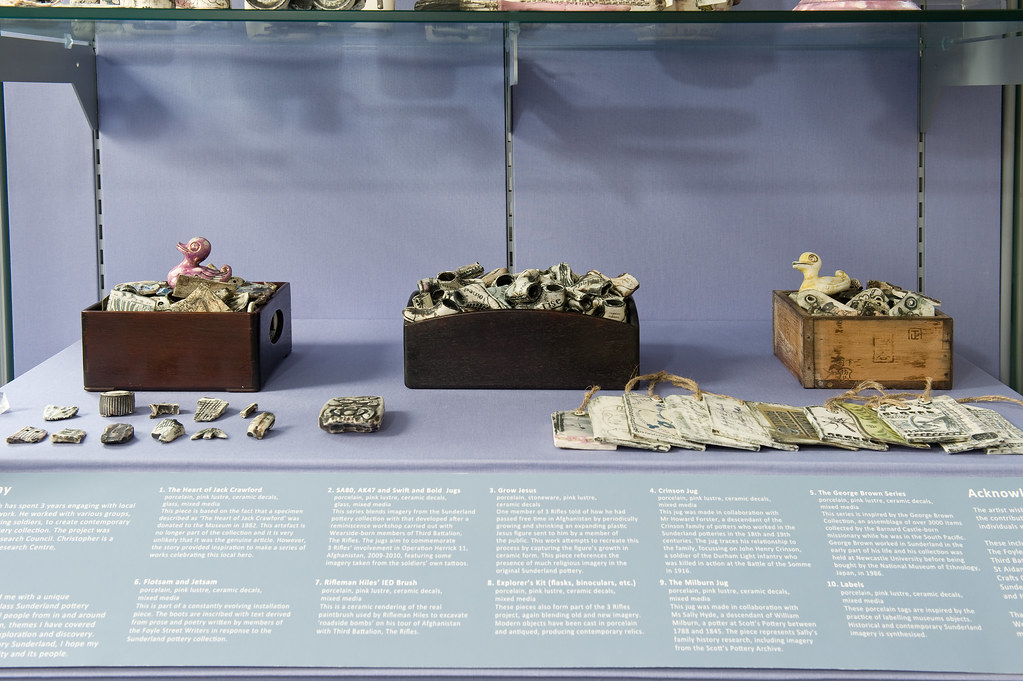 | |
| Flotsam and Jetsam, photograph by Colin Davison |
 |
| A detail of Flotsam and Jetsam, UAPS Gallery, Osaka. Photograph by Christopher McHugh, 2013. |
Click here to see slideshow of exhibition.
References
Editor 1887. ‘Jack Crawford [Notes and Corrections]’,
Monthly Chronicle of North Country Lore and Legend, Vol 1. (no 2; April). P. 91.
Previously advertised as running from 1 June - 28 July, 2013, Community in Clay is still open until further notice in the Pottery Gallery at Sunderland Museum & Winter Gardens.
Information for visitors to the Sunderland Museum & Winter Gardens can be found here.

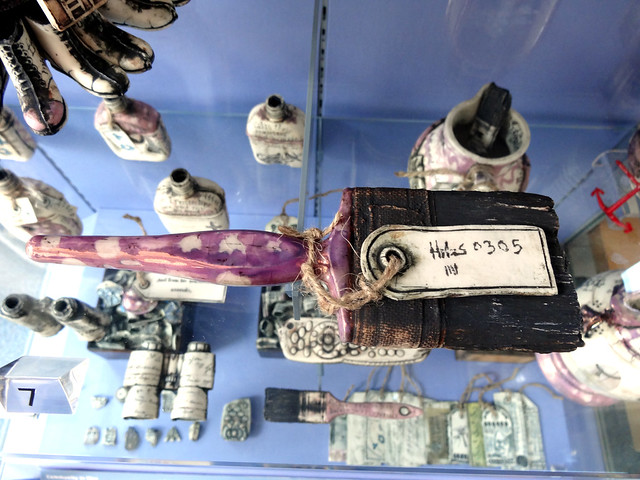
Great read!
ReplyDelete